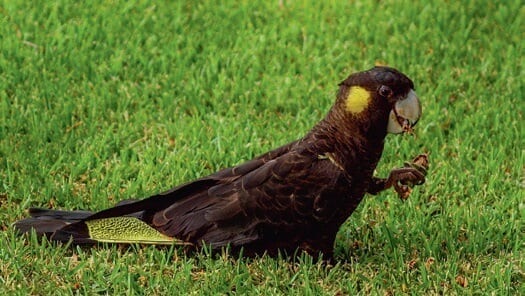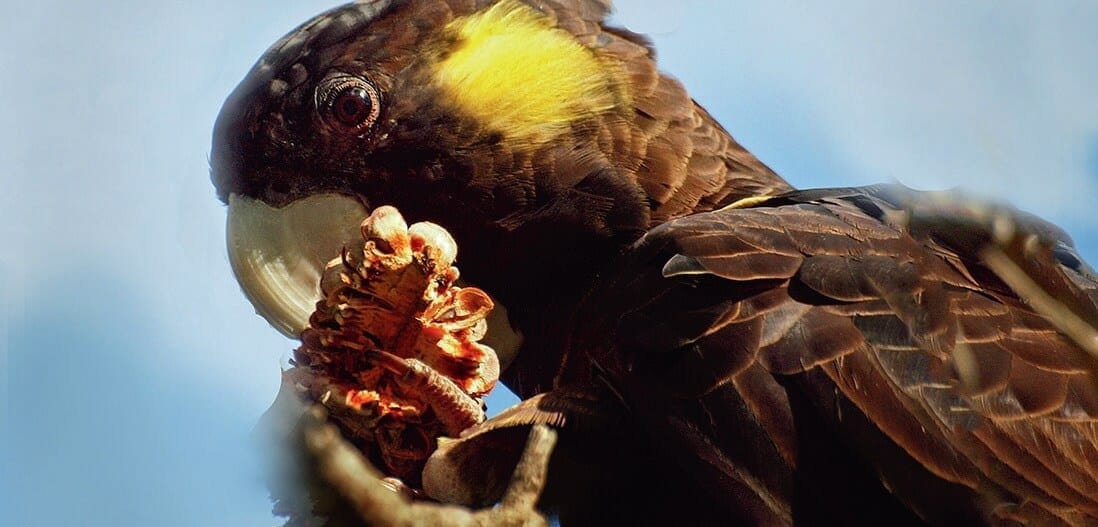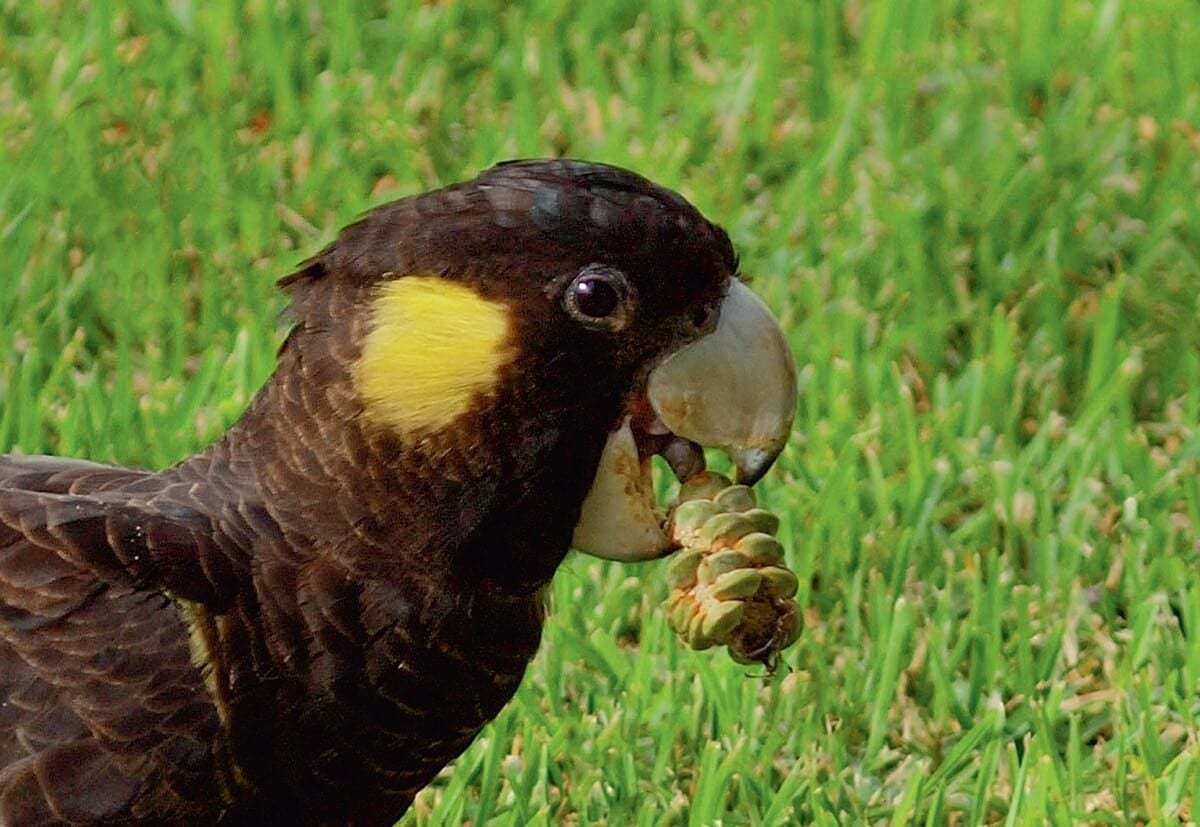Tags: Black Cockatoo. Wildlife, native, birds. Australian. Queensland. Brisbane. Moreton Bay
Not long ago Yellow-tailed Black-Cockatoos were quite uncommon on Bribie Island but recently they have been seen more frequently particularly in the state pine forests. Quite often while traveling on the Bribie Island Road near Ningi I have seen them flying overhead. So, keep watch and you might see them too.
Yellow-tailed Black- Cockatoos are large black birds 60-69 cm in length and weighing 620-900 g. They have yellow patches over their ears and large yellow feathers in their tails. On top of their heads are small black crests. Bills are large and strong designed for crushing and their feet have two toes in front and two toes at the back which allows for a strong grip. Males and females are slightly different with males having a pink eye ring and dark grey bill while females have a grey eye ring with a lighter coloured bill and a bigger yellow patch over their ears. In flight, their wings move in a slow, floppy action.
They keep contact during flight with mournful, screechy wails. Endemic to Australia, these Cockatoos are found from Rockhampton along a wide stretch of coast and slightly inland to the Eyre Peninsula in South Australia and in Tasmania. Eucalypt forests, state forest plantations, and rain forests are favoured haunts. In some areas, they venture into suburbia and into parks and gardens. They are locally migratory in the search of food. Favourite foods are seeds mostly from native trees such as Banksia, Eucalypts, Casuarinas, Hakeas, Grass trees, and Grevilleas. Insects are also eaten.
 It is common to see the Cockatoos holding their food with their feet while eating. Beetles and moth larvae are extracted from under the bark of wattle trees and with their strong bills, they dig into the wood several centimetres to obtain this food. Over the years they have begun to feed on the exotic pinecones. In fact, in one area in South Australia, they have become quite reliant on these imported trees. Their long breeding season begins in October and can extend through to May but is variable. Nests are built high up in large, old, tree hollows. Nest diameters are about 40cm and hollows from 1-2 m deep, so the hollows have to be very large indeed.
It is common to see the Cockatoos holding their food with their feet while eating. Beetles and moth larvae are extracted from under the bark of wattle trees and with their strong bills, they dig into the wood several centimetres to obtain this food. Over the years they have begun to feed on the exotic pinecones. In fact, in one area in South Australia, they have become quite reliant on these imported trees. Their long breeding season begins in October and can extend through to May but is variable. Nests are built high up in large, old, tree hollows. Nest diameters are about 40cm and hollows from 1-2 m deep, so the hollows have to be very large indeed.
The birds enter the hollows feet first. Two white eggs are laid on the woodchip nest floor and incubated by the female for about 28 days. During this time males feed the nesting females. One chick usually survives and is tended by the female for around 20 days. It is then cared for by both parents and remains in the nest for about 11 weeks and stays with them for about 6 months. After about 4 years the young birds are ready to breed. Their life span is about 20 years in the wild but much longer in captivity. There are 6 species of Black-Cockatoos in Australia.
 It is believed that Black-Cockatoos evolved in Gondwanaland before it broke up. Naturalist George Shaw was the first to record the Yellow-tailed Black-Cockatoo in 1794. Their scientific name funereus means “dressed for a funeral” referring to their black coat. The genus name Calyptorhynchus is derived from two Greek words calyplos meaning “hidden” and rhynchos meaning “beak”. Black-Cockatoos are regarded as pests in some areas because they strip the young foliage and branches from the plantation Eucalypt and Pine trees.
It is believed that Black-Cockatoos evolved in Gondwanaland before it broke up. Naturalist George Shaw was the first to record the Yellow-tailed Black-Cockatoo in 1794. Their scientific name funereus means “dressed for a funeral” referring to their black coat. The genus name Calyptorhynchus is derived from two Greek words calyplos meaning “hidden” and rhynchos meaning “beak”. Black-Cockatoos are regarded as pests in some areas because they strip the young foliage and branches from the plantation Eucalypt and Pine trees.
They also damage the bark on the trunks as they strip it off looking for larvae and beetles. Because of this, they were shot as pests in NSW until the 1940s. Because they need such large and mature trees to breed, usually over 200 years old, they are on the decline in some areas because of the clearing of old growth. This leaves them with less space to make their nests. Throughout their habitat areas, they are moderately common and listed as secure in most areas but in South Australia, they are recorded as vulnerable.
